|
Industry keeps watch as FAA lighting compliance is probed in Texas suit by kin of three soldiers
September 18, 2006 - Tower owners and obstruction lighting and monitoring companies throughout the nation will be closely watching lawsuits filed by attorneys for family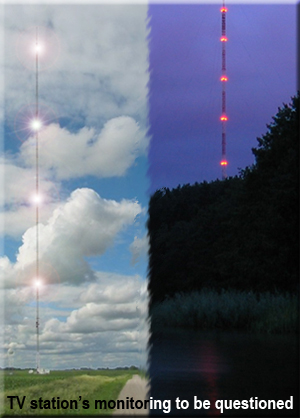 members of three soldiers who were killed in an Army Black Hawk helicopter when it crashed after striking the guy wires of a 1,738 foot television tower near Waco, Texas during November of 2004. members of three soldiers who were killed in an Army Black Hawk helicopter when it crashed after striking the guy wires of a 1,738 foot television tower near Waco, Texas during November of 2004.
The crash, which did not collapse the structure, occurred on an overcast morning in rural McLennan County, approximately 20 minutes into the Army helicopter's flight to Texarkana. Four other military men also died in the crash.
The lawsuit , filed earlier this month in state District Court in McLennan County, TX, names Centex Television Limited Partnership, which owns KXXV-TV in Waco; KSWO Television of Texas Inc., an Oklahoma corporation and member of the partnership; and KSWO Television Co. Inc., which owns all shares of KSWO Television of Texas Inc.
The suit says the TV station did not observe the Federal regulations and other guidelines that are in place to ensure aircraft safety.
Exigency vs. FAA policy
The plaintiffs say that a mitigating cause for the crash was because the television station's obstruction lighting system was not operating in compliance with Federal Aviation Authority standards and was in need of repair.
They believe that the FAA's 15-day allowable window for tower owners to fix malfunctioning lighting systems is too lax and the broadcast station should have repaired it immediately to ensure the safety of aircraft.
The suit also states that the defendants were negligent by failing to repair, maintain and keep the obstruction lighting in order; by not maintaining an automatic alarm system designed to detect and alert the station's engineers to a lighting failure; by not observing the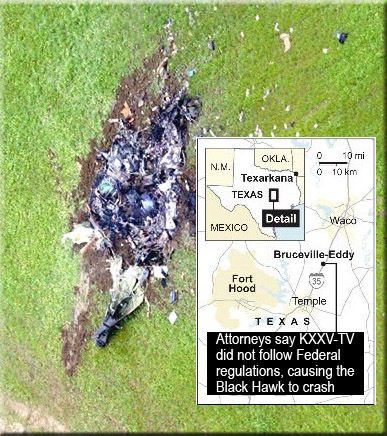 inoperative warning lights on the tower within 24 hours of the crash either visually or by observing an automatic indicator designed to register the failure; and installing warning lights on the tower that were inoperative, inadequate and unsafe. inoperative warning lights on the tower within 24 hours of the crash either visually or by observing an automatic indicator designed to register the failure; and installing warning lights on the tower that were inoperative, inadequate and unsafe.
Industry observers say that the defendants will argue that they followed the reporting requirements of the FAA, endeavored to bring the lights into conformance during the allowable period of time, and the accident was caused by the pilots not requesting or reviewing available information notifying them of the lighting failure as well as the pilots using visual flight rules during poor visibility conditions.
The broadcast station's previous lighting repairs will also be investigated to ensure that components used for repairs met FAA guidelines, a source close to the investigation said.
Reporting delay is key concern
"It appears that the station followed the guidelines set forth by the FAA for reporting their lighting outage," said a veteran New England broadcast engineer, "and I do believe that a jury will find that to be the case since I'm sure this has already been investigated thoroughly by the FAA."
However, he pointed out, if there is any indication that their engineers or management were knowledgeable that there was a system failure and "they sat on it and did not report it to the FAA in the required amount of time, then there is a strong likelihood that the plaintiffs will succeed in their suit."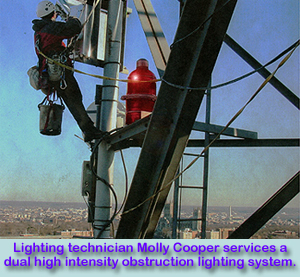
The station's high intensity lighting system had failed the week before the crash after strong storms hit the area. The station's management had notified the FAA and a Notice to Airmen (NOTAM) of the structure's lighting failure was issued, according to FAA spokesman Rolan Herwig.
The TV station's management had previously said that it was in compliance with all regulations at the time of the fatal crash. The plaintiffs disagree, stating that because Centex had failed to adequately and promptly maintain the lights, they created "a dangerous hazard to nearby aircraft, including the helicopter in which the plaintiffs' family members were passengers."
The NOTAM regarding KXXV-TV's tower was issued by the FAA on November 24. The accident occurred on November 29.
The FAA requires that light failures or monitoring alarms must be reported to their organization within 30 minutes of learning of the failure if the system cannot be made fully operational within 30 minutes. Repairs must be made within 15 days and logs must be kept of all events.
The agency also requires that obstruction lighting systems should be closely monitored by visual or automatic means at least once every 24 hours.
In addition, lighting systems must be inspected, as a minimum, once every 90 days, according to a directive in the code or regulations.
The plaintiffs' attorneys will propose that there was gross negligence by the broadcaster's management charged to ensure that that the lighting system was properly monitored and maintained.
"I honestly believe that the attorneys are the only ones that will be enriched in this action," offered a Nashville broadcast engineer who read the suit and requested anonymity. "They're probably looking for a settlement. Any station can be sued for anything. Unfortunately, this is a high profile case, and because most Americans are in support of our soldiers because of the many deaths in Iraq, they might lend themselves towards a judgment in favor of the pilots' families," he said.
A meteorologist at the National Weather Service's Fort Worth office reported that clouds that had moved into the area overnight before the early morning crash produced visibilities varying from 10 miles to less than one-half mile in the early morning hours.
The fog was so thick when emergency crews arrived that they could not see more than halfway up the tower, authorities said.

Federal Regulations Effecting Obstruction and Aviation Lighting
WirelessEstimator.com has referenced areas in the Code of Federal Regulations and FAA Advisory Circulars to assist those interested in obtaining answers to the most often asked questions regarding obstruction lighting and marking as well as reporting and monitoring requirements for tower owners. It is not intended to provide guidance to ensure full compliance with all regulatory requirements. CLICK HERE |
The lawsuit was filed by family members of Chief Warrant Officer 2 David H. Gardner Jr., 32, of Mason City, Iowa, and Chief Warrant Officer 2 Mark W. Evans Jr., 27, of Jacksonville, Florida, who were the Black Hawk's pilots; and Capt. Todd T. Christmas, 26, of Wagon Mound, New Mexico.
Dallas attorney Andy Payne, of Payne Law Group, who filed the lawsuit on behalf of Erica Smith Christmas, said that his position is that Centex knew the lights had gone out, and they had a duty to fix them as soon as they knew they were out, but didn't.
"When they are out," Payne said, "this presents a tremendously dangerous situation to aircraft, and they need to fix it, not within two or three or four days, but immediately."
Nelson Roach of Nix, Patterson & Roach, has joined Payne in representing the families of Army pilots Gardner and Evans.
"The saddest thing about this tragedy is that it could easily have been avoided," said Roach on Friday. "If it weren't for the abject negligence of the defendants, these seven soldiers would be alive today."
Military says crash resulted from pilots' errors
Army investigators said last year that the fatal crash was caused by the Army pilots' attempt to fly under visual flight rules in poor weather conditions.
Maj. Gen. James D. Thurman, commanding general of the 4th Infantry Division, said then that administrative disciplinary action was taken against the company and battalion commander and two members of the chain of command. The company commander was removed. Details concerning the administrative action were not released.
Lieff Cabraser Heimann & Bernstein, LLP, a San Francisco law firm specializing in aviation suits, is representing the family of another soldier who died in the crash.
"While the outage had apparently been reported to the Federal Aviation Administration, and a Notice to Airmen issued, several questions remain regarding the sufficiency of the report and notice, the sufficiency of markings on the cables and tower in the absence of lights, the flight plan and weather, and the performance of the helicopter itself," the firm's newsletter said. A suit on behalf of their client has not been filed.
The KXXV-TV guyed tower is neither painted nor required to be painted, according to Centex Television's Federal Communication Commission's antenna structure registration that does not reference marking guidelines as detailed in the Obstruction and Marking Guidelines .
Due to extremely poor visibility one of the pilots contacted a Waco Regional airport controller requesting an instrument flight plan when the accident occurred. At that time the helicopter was traveling at approximately 800 feet above ground level in an area that had multiple towers exceeding double that height.
New NOTAM issued for same site
Hundreds of obstruction lighting outages are common throughout the country every day. A search of the Killeen-Fort Hood Regional Airport (GRK) within a 50 mile radius on September 12 identified 20 structures reporting system failures, the KXXV-TV tower being one of those listed.
The broadcast station reportedly employs a five level high intensity lighting system for the 1738' structure with a total of 15 high intensity lights during the day. A twilight mode will be followed during the nighttime hours to medium intensity lighting.
If any one of those lights fail, or fails to change to the proper intensity, an alarm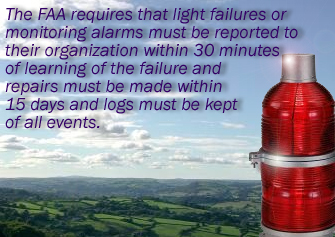 will notify the station's management if a monitoring system is utilized or if it is observed by the station's employees or its representative. The station or their monitoring representative must then provide a telephone report to the nearest Flight Service Station or office of the Federal Aviation Administration of the known extinguishment or improper functioning of the flashing obstruction light, regardless of its position on the antenna structure, not corrected within 30 minutes. will notify the station's management if a monitoring system is utilized or if it is observed by the station's employees or its representative. The station or their monitoring representative must then provide a telephone report to the nearest Flight Service Station or office of the Federal Aviation Administration of the known extinguishment or improper functioning of the flashing obstruction light, regardless of its position on the antenna structure, not corrected within 30 minutes.
If any system failure is visually observed, including some that may not be detected by monitoring systems such as lights that are not flashing in synchronization, then it too must be reported immediately.
If the tower lights' monitoring system is malfunctioning then a report must be made and a NOTAM will be filed by the FAA.
The 15 days allowed to bring a system back into compliance was established so that tower owners would have enough time to be able to marshal a maintenance company to identify the cause of the failure, order the proper equipment and make the required repairs.
15-day window argued as reasonable
The plaintiffs appear to be proposing that the 15-day period is too long of a time and that KXXV-TV's engineers should have expedited immediate repairs as soon as the lights failed. Tower owners disagree.
"The 15-day window was set because the FAA is well aware of the extensive diagnostics that are required once you mobilize a company and the time that it takes to get the parts necessary to make the repair; plus the repair itself," explained a Midwest owner of seven towers, four of them required to be lamped.
"Most people don't realize that it's not 'plug and play' and it's not changing a light bulb. This is a sophisticated lighting system," he said.
High intensity lighting systems are oftentimes designed specifically for each tower site and manufacturers or tower maintenance companies may not have replacement units in stock. Each new lighting unit manufactured must go into a burn in room where the light is tested under operating conditions to ensure that it meets standards.
It is then placed into a tunnel to identify that it meets optical conformity which includes ground scatter testing and assurance of the proper light color before it can become ETL certified. This process could take up to two days or more.
During times of catastrophic failures such as Hurricane Katrina's decimation of many towers, lead times for lighting systems can be considerable. The FAA recognizes that it isn't always possible to fix a system within 15 days and will allow the owner to request an extension.
A station engineer for KXXV-TV said Friday that due to the current litigation he could not comment on the type of lighting system the tower has and the reasons for the 2004 failure and last week's malfunction.
Upcoming depositions will identify whether the KXXV-TV lighting system experienced a total loss of all obstruction lighting or if the problem was an isolated one on the structure that would not have prevented pilots from seeing the guyed tower during normal nighttime flight conditions.
In example, at all required levels, three high intensity strobe lights are required so that one of them will be visible to a pilot no matter what direction he is approaching the tower from. A failure of a unit in the opposite direction would not affect his ability to notice the warning lights.
NOTAMs not necessarily covered in briefing
The main topic of a briefing a pilot will receive from a flight briefing specialist will be the weather, said John Hettish, President of Middle Tennessee Two-way, Inc. Hettish, a private pilot, is also actively involved in the installation and maintenance of obstruction lighting systems for his clients.
"Notices to Airmen, which are temporary hazards to flight are rarely discussed, but the information is available to the pilot. If the temporary hazard is particularly bad, such as a massive forest fire in the vicinity of the flight, the briefer will definitely bring it up, but not the normal run of the mill NOTAMs," Hettish said.
However, he explained, "If requested by the pilot, each and every NOTAM affecting his flight path will be made available to him. Rarely is a tower more than 2,000 feet above ground level. These are plainly marked on the aerial maps for the path of flight and it is the pilot's responsibility to know where these are."
Flight briefings can be done over a telephone or on the internet where there will be an opportunity for the pilot to request a list of NOTAMs. For a pilot to know the location of every hazard it would be necessary for him to plot each one on a navigational map and then determine if the temporary hazards, such as KXXV-TV's lighting outage, would be a factor.
Hettish said it is rare that a pilot will engage in detailed plotting of all NOTAMs. "For the pilot and his passengers the best defense against colliding with objects attached to the ground is to fly at a reasonable altitude. Often the last phrase given by a flight safety specialist is, 'Caution, high speed military operations are in effect.' This means that military can fly as low as they please and are not limited to 250 knots of speed below 10,000 feet as civilian aircraft are," he explained.
The crash occurred at the highest point in McLennan County, with 30 different structures in a tower farm within a five-mile radius of where the helicopter went down, some of the structures having incandescent lighting and painted banding for their tower as required by the FAA.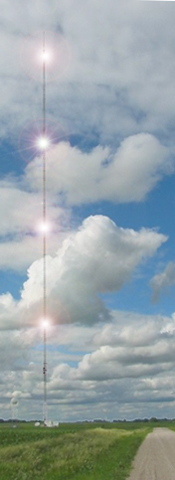 A neighboring tower may have different requirements based upon regulatory authorities and the applicant's request. A neighboring tower may have different requirements based upon regulatory authorities and the applicant's request.
The Black Hawk helicopter, which the military began using in 1979, is the Army's main troop transport helicopter. It can carry 15 people, including a crew of four. The helicopter hit at least five of the 21 wires supporting the tower, according to a representative of the Waco-Temple-Killeen television station.
The deceased's families are unable to sue the Army for deaths arising from or in the course of activity incident to military service, according to the Feres Doctrine in which the U.S. Supreme Court declared in 1950 that active duty servicemen and their estates could not recover money against the U.S. government.
Four members of an elite Army unit known as the Night Stalkers died on June 1 when their MH-47E Chinook helicopter crashed into a guyed tower in Doerun, GA. The co-pilot survived the crash which is still under investigation.
FCC fines vary based upon compliance issue
If the Texas suit brings forth information that identifies a violation of FAA regulations, it is not known if the Federal Communications Commission can cite the station for those violations.
In 2001 Telecorp Communications, Inc. or Arlington, VA, was fine $80,000 for lighting and marking violations.
American Tower Corporation was issued a Notice of Apparent Liability for Forfeiture in the amount of $212,000 in 2001 just for ownership and registration infractions.
The FAA routinely alerts FCC field offices when tower owners fail to report that lighting outages have been repaired within the 15 day NOTAM period, or a tower owner has requested that a NOTAM be extended. It was during the FCC's follow-up to the FAA's notification that the Commission became aware of a wide-spread problem.
The FCC fined a Gary, IN, AM station $16,000 last April for noncompliance with a tower registration requirement, failure to notify the FAA of a known antenna structure light outage and failure to exhibit the required red obstruction lighting.
However, the FCC is restricted by caps on the fines that it can levy, but if a jury finds KXXV-TV's parent and associated companies culpable in the deaths of the Army airmen, the awards could be considerable.
Copyright 2006, Wireless Estimator, Inc. Please request reprint permission.
|